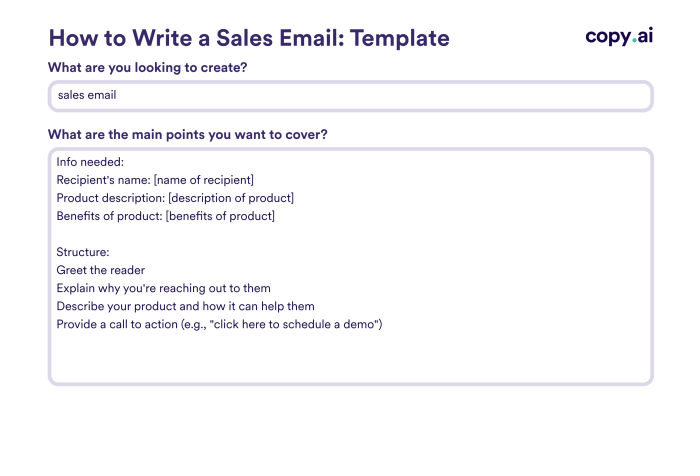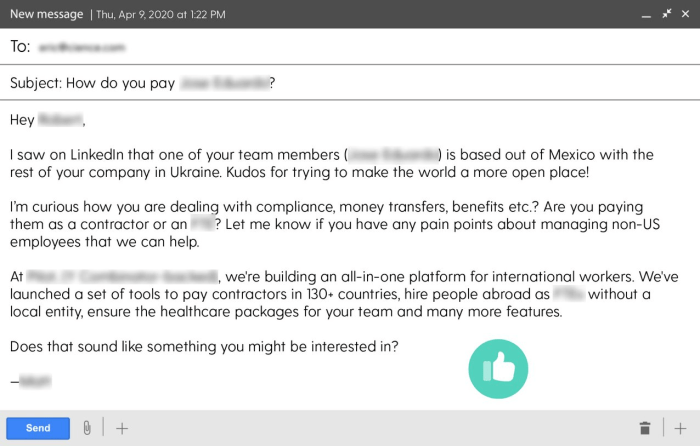Creating Effective Sales Emails sets the stage for successful communication with your audience. Get ready to dive into the art of crafting engaging emails that drive results and captivate your readers.
Introduction to Sales Emails
Sales emails are a crucial aspect of business communication, serving as a direct way to reach potential customers and promote products or services. These emails are designed to capture the recipient’s attention, generate interest, and ultimately drive them to take action, such as making a purchase or scheduling a meeting.
One example of a successful sales email is one that includes personalized content tailored to the recipient’s interests and needs. By addressing the recipient by name and providing relevant information, the email can establish a connection and increase the likelihood of a positive response.
Key components of an effective sales email include a compelling subject line that grabs the recipient’s attention, a clear and concise message that highlights the benefits of the product or service, a strong call-to-action that prompts the recipient to take the desired action, and a professional and engaging tone that reflects the brand’s image.
Understanding Your Audience
Knowing your target audience is crucial when creating sales emails. Understanding their needs, preferences, and pain points allows you to tailor your message to resonate with them effectively.
Personalization is key in making your sales emails more impactful. By addressing your audience by their name, referencing their specific interests or previous interactions with your brand, you show that you value them as individuals. This personal touch can significantly increase engagement and conversion rates.
Tips for Researching Your Audience
To better understand your audience, conduct thorough research. Utilize tools like Google Analytics to gather demographic data, analyze social media engagement to uncover interests, and send surveys to collect feedback directly from your audience.
Enhancing Sales Emails through Personalization
Personalization goes beyond simply using the recipient’s name. Tailor the content of your emails based on their past interactions, purchase history, or preferences. This level of customization can create a stronger connection and increase the likelihood of a positive response from your audience.
Crafting Compelling Subject Lines: Creating Effective Sales Emails

When it comes to sales emails, the subject line is your first impression and can make or break whether your email gets opened. Crafting compelling subject lines is crucial to grabbing the recipient’s attention and increasing open rates.
Importance of Subject Lines
The subject line is the first thing recipients see in their inbox, so it’s essential to make it engaging and clickable. A captivating subject line can entice the recipient to open the email and engage with your content, ultimately leading to a higher conversion rate.
Best Practices for Creating Engaging Subject Lines
- Keep it concise: Aim for around 50 characters or less to ensure the entire subject line is visible on all devices.
- Personalize when possible: Use the recipient’s name or personalize the subject line based on their interests or previous interactions with your brand.
- Create a sense of urgency: Use words like “limited time offer” or “act now” to create a sense of urgency and encourage immediate action.
- Avoid spam trigger words: Stay away from all caps, excessive punctuation, and spam trigger words like “free” or “guaranteed” to prevent your emails from ending up in the spam folder.
- Use emojis strategically: Emojis can help your subject line stand out, but make sure they are relevant to your content and audience.
Using A/B Testing for Subject Line Optimization
A/B testing involves sending out two versions of the same email with different subject lines to a small portion of your audience to see which one performs better. By analyzing the open rates of each version, you can determine which subject line resonates more with your audience and optimize future email campaigns accordingly.
Writing Persuasive Email Copy
To create a persuasive sales email, it’s essential to maintain a conversational tone that resonates with your audience. This helps in building a connection and capturing their interest right from the start. When writing the email copy, focus on being clear, concise, and compelling to drive action from the reader.
Crafting Clear and Compelling Content
One tip for writing persuasive email copy is to keep your content focused and to the point. Avoid using jargon or complex language that might confuse the recipient. Instead, use simple and direct language to clearly convey your message.
Remember, the goal is to make it easy for the reader to understand the value proposition and take the desired action.
Another effective strategy is to incorporate storytelling into your email. Sharing a relevant story or scenario can help engage the reader on an emotional level and make your message more memorable. Additionally, including testimonials from satisfied customers can add credibility to your claims and persuade the recipient to trust your product or service.
Overall, the key to writing persuasive email copy is to understand your audience, speak their language, and provide compelling reasons for them to take action. By maintaining a conversational tone, crafting clear and concise content, and incorporating storytelling and testimonials, you can create emails that drive results and generate leads for your business.
Call-to-Action (CTA) Strategies

When it comes to sales emails, a strong Call-to-Action (CTA) plays a crucial role in guiding the recipient’s next steps. It is the final push that encourages the reader to take action, whether it’s making a purchase, signing up for a service, or simply engaging further with the content.
Creating a Sense of Urgency
One effective CTA strategy is to create a sense of urgency. By using phrases like “Limited Time Offer” or “Act Now,” you can motivate the recipient to act quickly before they miss out on a valuable opportunity. This urgency can lead to higher conversion rates and increased engagement.
Providing Value through CTAs
Another important aspect of CTAs is to clearly communicate the value proposition. Whether it’s highlighting the benefits of a product or service, offering a discount or free trial, or showcasing customer testimonials, the CTA should clearly convey the value the recipient will gain by taking action.
Design and Formatting Tips
In order to create effective sales emails, it is important to pay attention to the design and formatting of your messages. A well-designed email with a clear layout can help catch the reader’s eye and encourage them to engage with your content.
Using Images, Colors, Fonts, and White Space
When incorporating images into your sales emails, make sure they are relevant to your message and enhance the overall look of the email. Use colors strategically to draw attention to key points or calls-to-action. Choose fonts that are easy to read and align with your brand’s style. Utilize white space to create a clean and organized layout that is visually appealing.
Responsive Design Considerations
With the increasing use of mobile devices, it is essential to optimize your sales emails for different screen sizes. Ensure that your emails are responsive and adapt well to various devices, such as smartphones and tablets. Test your emails across different platforms to guarantee a seamless viewing experience for all recipients.
Analyzing and Optimizing Sales Emails
When it comes to sales emails, tracking key metrics like open rates, click-through rates, and conversions is crucial for assessing the effectiveness of your campaigns. By analyzing these metrics, you can gain valuable insights into how your audience is engaging with your emails and make data-driven decisions to optimize your email strategy.
Importance of Tracking Metrics, Creating Effective Sales Emails
- Open Rates: Measure the percentage of recipients who open your emails. A high open rate indicates that your subject lines are compelling and relevant to your audience.
- Click-Through Rates: Reflect the number of recipients who clicked on a link within your email. This metric shows how engaging your email content is and whether it motivates action.
- Conversions: Track the number of recipients who completed a desired action, such as making a purchase or signing up for a webinar. Conversions indicate the overall success of your email campaign in driving desired outcomes.
Analyzing Performance and Optimization
- Review Metrics: Regularly review your email metrics to identify trends and patterns in audience behavior. Look for areas of improvement and opportunities for optimization.
- Data-Driven Decisions: Use the insights from your metrics to make informed decisions about adjusting subject lines, email copy, and call-to-action buttons to improve performance.
- Segmentation: Segment your email list based on engagement levels to tailor content to specific audience segments. Personalization can significantly impact email performance.
A/B Testing Strategies
- Subject Lines: Test different subject lines to see which ones resonate best with your audience. Use A/B testing tools to measure open rates and determine the most effective approach.
- Email Copy: Experiment with varying copy lengths, tones, and content formats to see what drives higher engagement and conversions. Testimonials, offers, and storytelling can all impact email performance.
- Call-to-Action Buttons: Test different CTA button colors, text, and placements to see which combinations drive the highest click-through rates and conversions. Optimize based on the results of your tests.






